This is a transcript of a Widex live webinar on AudiologyOnline. Download supplemental course materials.
Today’s program is Tinnitus Management Fundamentals: Widex Zen Therapy. For those of you who would like additional information, we do have recorded courses on AudiologyOnline pertaining to tinnitus and advanced tinnitus techniques with Zen Therapy. Widex prides itself as a premier manufacturer for tinnitus management. I am excited to go over this step-by-step introduction course to Widex Zen Therapy.
On today’s agenda, we will first review the building blocks of what we need in order to have an effective tinnitus management program. We will talk about the essentials of building up to a comprehensive step-by-step approach for tinnitus management. Then we will introduce Zen. For those of you who are already familiar with Zen, this might be somewhat of a review. Widex has had Zen technology for over five years, and it has been proven to be very successful in the field as a sound therapy tool, as well as promoting relaxation and decreasing one’s awareness of tinnitus. We will go over how to fit Zen for a basic or mild tinnitus patient. Lastly, we will introduce the basics of the Widex Zen Therapy program, which as many of you know, was introduced in November 2012. It has been exciting to see the positive field results of the Zen technology, and now we are able to have a comprehensive step-by-step practical approach to a thorough tinnitus management program.
Effective Tinnitus Management
What are the building blocks that we need in order to achieve our ultimate goal of habituation? We need a combination plan to work through this process. We need to include things like counseling and stress management, but we also need to look at using sound therapy in combination with amplification. Those of you using the Zen tones in combination with the Widex hearing aid technology might have already noticed success in some of your mild tinnitus patients. Perhaps you have even offered some basic counseling as well. We know that there is no cure for tinnitus, but we certainly know that we have solutions, and we need to be able to look at all of these components in an efficient treatment plan.
What is habituation? Essentially, habituation is the brain’s ability to re-learn to treat tinnitus as an unimportant or a non-threatening event. It is the process of being able to ignore the tinnitus so that it does not negatively impact quality of life. The benefit of habituation offers patients the ability to have reduced annoyance from their tinnitus and to improve relaxation and sleep. Stress and anxiety are often associated with people who have more severe tinnitus, and sleep becomes a serious concern for those patients. The Widex Zen Therapy program looks at strategies to address each of these components, improve the ability to concentrate and decrease the sense of helplessness and loss of control that these patients often feel with tinnitus. We want to empower them by letting them know that they can habituate to their tinnitus, just as they habituate to some other environmental disturbances.
Some examples of habituation include wearing a watch, jewelry, clothes or glasses on our face. Our brain learns to be able to ignore these things, especially new things over time, so that they do not affect us or draw attention on a daily basis. You can share with the patient that our brain has the ability to categorize something as meaningful or non-meaningful. You might live close to a train that runs by several times a day. I personally live in New York City, and there are all sorts of city sounds like sirens and car horns to which I have habituated. I am able to ignore the bursts of sounds from the nearby subway construction in the night. My brain has registered this information as unimportant, and I know that it is a non-threatening event, so I can ignore it. These are some examples that you can provide to your patient as you guide them through understanding what habituation is and how they can use certain tools to habituate to their tinnitus. Remember there is no cure for tinnitus, but we certainly have a solution for them to be able to manage it.
What is Zen?
As a form of sound therapy, Widex invented and uses Zen, which is our patented fractal technology. Fractal technology is based off of a mathematical system which allows for these chime-like tones to be played at random. The tones are based off of the relaxation points of music; it allows for the patient to listen to something that can help alleviate the stress and anxiety in a better way than narrowband or broadband noise. Even if a noise is modulated, it still does not offer any element of relaxation. The Zen fractal tones are unique by being able to offer pleasant chime-like tones at random. We also know that music is a very powerful tool that activates many structures of the brain that underlie both tinnitus and the stress response that some associate with hearing tinnitus.
Zen technology is different from pre-recorded, traditional music. It is not a track that cycles over and over and gets stuck in your head. We call those “ear worms.” You know that having the same song stuck in your head can be annoying. We do not want to have pre-recorded music getting stuck in a patient’s head while they are actively listening to it. We want patients to be able to passively listen to something in the background and, as a result, promote habituation. The Zen tones offer unique features that are like no other type of sound therapy currently available in the industry. We are able to provide our patients with auditory stimulation, which is important for tinnitus and stress management.
As I said before, mMusic is a powerful tool to activate various structures of the brain. Figure 1 shows a PET scan with the brain at rest and also when activated by music. You can see that many areas of the brain are stimulated; by re-stimulating the areas of the brain which happen to be connected to one’s tinnitus, such as the cerebellum, the frontal lobe, the limbic system and the auditory system, it allows us to re-engage those areas of the brain and provide auditory stimulation. All of the tinnitus research shares a common thread that the longer a person goes without treating their tinnitus, the more areas of the brain start to misfire or become cortically re-organized. We want to be able to offer auditory stimulation in the form of something that is pleasing and relaxing. Zen is the optimal choice for sound therapy as the music tones allow for the brain to respond. Different neural transmitters release both physical and emotional responses.
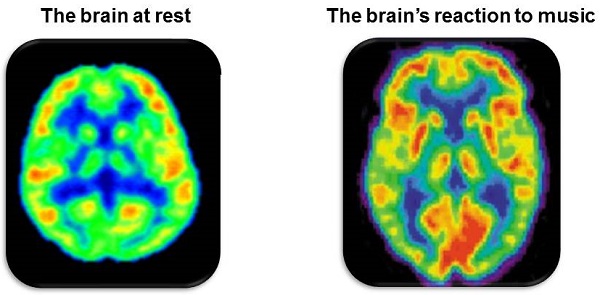
Figure 1. PET scan of brain at rest (left) and while listening to music (right).
Music can create a physical response like chills or increase in heart rate. Some people like to use faster tempo music when exercising to elicit a high-energy physical response, but this kind of music in relation to tinnitus can cause a negative physical and emotional response. A patient might express the emotion of fear or anxiety, with the result of increases in their heart rate or blood pressure. We want to be able to use music that will offer a calming resting heart rate as well as elicit an emotional response of relaxation, easiness and even happiness. Hollywood uses music all the time to be able to evoke these types of responses in movies. Two notes from Jaws, and right away you might feel scared, which is an emotional response, and maybe the hairs on your body start to stand up, which is a physical response. Music is a powerful resource for us to tap into.
The Zen fractal tones have been proven to enhance that relaxation response. It also allows for patients to be able to passively listen to the tones and mingle with their tinnitus in the background. The tones are only at a 3 to 5 dB sensation level relative to their Sensogram measurement, which we will discuss later. These tones are very subdued. We also allow for a variety of Zen tone options, which we call Zen colors. We know that variety and flexibility is important when working with tinnitus patients, and we even have a Zen noise, as well as a shaped noise option, for those patients who are a little more severe or having a worse day than usual with their tinnitus. The extra noise can take the edge off earlier on in their treatment plan. Of course, Widex is not looking to mask the tinnitus. We are using sound stimulation, not a masking protocol. But we do offer a variety of options and flexibility from which you and your patients can choose.
We know that 80% of our patients with hearing loss also have tinnitus, so Widex uses a combination device to also treat hearing loss at the same time. Conversely, for that patient who does not present with hearing loss, these devices can be set without amplification. It is a great investment for patients to have the option of both modes, with or without hearing loss. This will be filtered in accordance to their individual hearing loss as you program the device. We will go through the programming in just a moment. The efficacy of the Zen program has been proven by independent studies from all over the globe, which are listed in Appendix A.
Widex Zen Therapy
As I mentioned earlier, Widex Zen Therapy was launched in the United States in November 2013. We came up with the Widex Zen Therapy program because we know that people have successfully used other programs that involved a combination of counseling and amplification. Maybe this is something that you are already using in your office. Maybe you have used counseling and stress reduction methods, depending upon the patient’s needs, or even just sound stimulation with counseling. Widex understands that we do need to look at different components in order to achieve a successful and comprehensive treatment plan approach. All of the components involved, such as counseling, amplification, relaxation, stress management, and sleep, along with the fractal tones, offer a very comprehensive approach for your patients.
Test Patient
We are going to talk about a basic tinnitus patient. Meet Gloria. She is a 59-year-old social worker. She leads an active, social life and has some difficulty hearing her clients. She has some hearing loss, but she also reports tinnitus that is more bothersome when she is in quiet. While she is doing her paperwork, she notices her tinnitus, but her primary concern in visiting you is the fact that her hearing loss is starting to have an impact on her quality of life and interactions with clients. How can we get started with the Widex Zen Therapy program to help Gloria?
We have made the Widex Zen Therapy program a simple three-step process. Figure 2 is an example of our evaluation and treatment plan checklist within the Widex Zen Therapy toolbox. The first step is the assessment, and the checklist covers each item that you need to complete and date in the patient’s chart. Second is the treatment plan. Once you have received medical clearance and know to what degree their quality of life is being impacted by their tinnitus, you can begin to decide what components of the Widex Zen Therapy program they will need. You can see on this checklist (Figure 2) that we have referenced the associated tools to help guide you throughout each item under Treatment Plan. The third step is follow-up. It is important to have follow-up visits to make sure that we are tracking progress and that we have chosen the correct route for the patient.
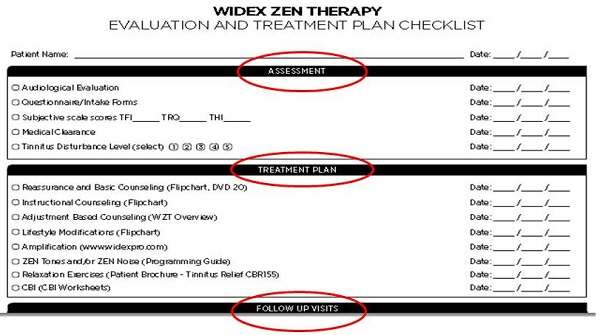
Figure 2. Example of treatment plan checklist for Widex Zen Therapy.
Assessment
The assessment process includes the audiological evaluation as well as other measures of tinnitus disturbance. You want to make sure that your patient has been medically cleared by a physician so that you are confident in proceeding without medical contraindications. Next, we offer a Widex Zen Therapy intake questionnaire. This will give you information about your patient’s lifestyle. Have they had any treatment prior to seeing you? How is their tinnitus negatively affecting their quality of life? You will need a basic hearing test to be able to fit the Zen technology and access the Widex Zen Therapy program. We do not require any additional diagnostic testing; however, if this is something that you are already using in your practice, then continue to use that diagnostic protocol as it gives you and your patient more information about their tinnitus.
Lastly, a subjective measurement scale is needed. Widex provides three options for you to use: the Tinnitus Functional Index (TFI), Tinnitus Reaction Questionnaire (TRQ) and Tinnitus Handicap Inventory (THI). All three of these scales will allow you to determine your patient’s baseline for how tinnitus negatively impacts their life. For example, Gloria reported some mild tinnitus disturbance when she is in quiet. Based on her score of this subjective measurement scale, we would classify her as a level 2 patient. All of those scales add up to a score of 100 to 104. The majority of patients that we see and can help easily fall within this greater bottom portion of the disturbance level pyramid (Figure 3).
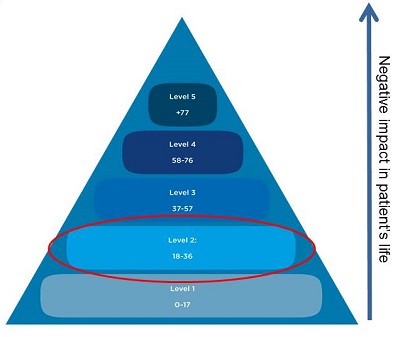
Figure 3. Tinnitus Disturbance Level Pyramid.
What do we need to be able to treat a patient like Gloria? The Widex Zen Therapy overview and manual suggest treatment plan components based on how they score on the disturbance level pyramid (Figure 4). For example, Gloria has a mild negative tinnitus reaction. We are going to give Gloria some instructional and adjustment-based counseling and amplification for her hearing loss. She came in reporting hearing loss as her primary concern, so we are going to fit Zen in Gloria’s aids for her to be able to use in quiet environments. We might even give her some relaxation exercises, which can be useful to all people, I believe, to take the edge off and work on stress management. Again, this all comes from the Widex Zen Therapy toolbox.
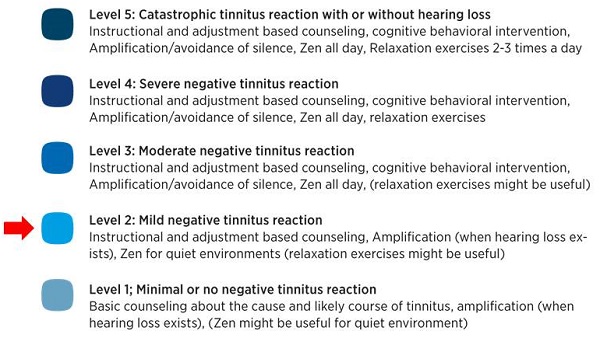
Figure 4. Levels of individual reaction to tinnitus and the recommended steps of the treatment plan.
Counseling and Technology
We have broken down the program into two sections: counseling and technology. Technology includes amplification as well as the fractal tones. Counseling encompasses relaxation or stress management and counseling techniques. Both components are equally as important when offering a comprehensive approach and an effective tinnitus management program. For many patients, it is not enough to fit them with their hearing aids and turn on the Zen. You do have to add the counseling piece to have the most successful treatment plan possible. For some patients, you might notice that hearing aids alone are a relief for a very mild tinnitus patient. For the more moderate tinnitus patient, the addition of counseling will be important. Adding the counseling and relaxation pieces becomes more critical as the tinnitus becomes more severe.
Amplification
What are the ideal characteristics of amplification for your patients, including those with tinnitus? Widex has four signature features that are standard in all of our technologies: low compression threshold, broad bandwidth, Sensogram and flexible amplification options. A low compression threshold is an excellent benefit to patients with tinnitus as it allows for them to be able to hear soft sounds in their environment. It takes away the contrast between silence and tinnitus. We always tell tinnitus patients to stay out of quiet environments. Widex has a broad bandwidth, and, in some of our instruments, extends all the way out past 10,000 Hz. As we talked about earlier, one common thread with tinnitus is lack of stimulation or auditory deprivation. Tinnitus tends to reside in the high frequencies for many patients, and to be able to stimulate or provide information in those regions is an advantage for both your tinnitus and hearing-impaired patients.
Sensogram is the basis of all Widex hearing device and Zen fittings, and it allows you to have precision and accuracy on the first fit of both the amplification and Zen settings. The Sensogram filters both the amplification and the levels of the Zen tones according to that individual's specific hearing loss. Flexible amplification options are key when working with patients of different backgrounds and amplification needs. We talked about the variety of Zen tones as well as Zen noise and microphone off/on options that are available in our software. These options provide the patient with control and flexibility when using the instrument, as well as to the professional who will be fitting that instrument.
How to Fit Zen
Figure 5 shows the Widex product families that offer Zen. All of our technology has Zen either as a standard or optional feature. Our latest product family, Dream, offers Zen as a standard feature throughout all levels of technology and styles as well. We have a multitude of other instruments, product families, levels of technology and styles that also include Zen.
We have also recently launched a product called ZEN2GO, which is an out-of-the-box solution for your patients with normal hearing. This is a tinnitus management tool that is already pre-programmed with the Widex Zen Therapy basic programming and the microphones turned off. It is a Passion-style hearing aid, and it comes prepackaged and set with an RC-DEX to give the patient control of the volume as well as program. You can spend your time in the office doing the counseling portion while being able to provide your patient with the tinnitus management tool right out of the box. It does have flexibility to be connected to the computer and modified if needed.
It is important to take into account binaural considerations. No matter where the tinnitus originates, it almost always becomes a central nervous system matter. It is important to be able to stimulate the entire auditory system. Even if they have tinnitus in both ears, hearing loss in one ear, or a scenario of tinnitus and hearing loss only in one ear, it is important that you fit both ears, as we need to engage the entire system because of the central nervous system component to tinnitus. Always choose a binaural fitting unless there is a dead ear.
Programming
Programming Zen takes three simple steps (Figure 5). First, you will do a Sensogram, which, as I mentioned, is the basis of all Widex technology fittings. Next, you are going to do a feedback test. Our software offers the ability to estimate a feedback test should you have a patient with some sensitivity or hyperacusis where the physical test is not feasible. Then you are going to fit the Zen in the Smart Toggle options for the basic suggested fitting, which allows the Zen program to be available in what we call a Zen universe. The patient will access Zen by either a long push of the button or a long push on the remote control.
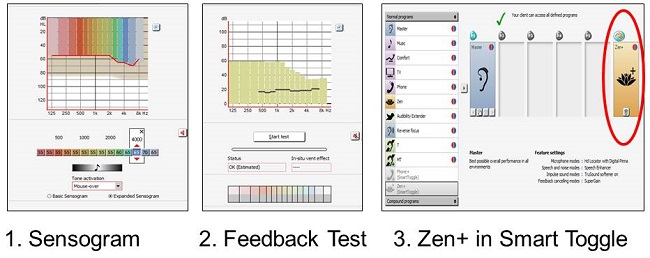
Figure 5. Programming Zen in three simple steps: Sensogram, feedback test, Zen+ in Smart Toggle.
Zen+ or Smart Toggle offers allows for three Zen settings in the Zen universe (Figure 6). You can see there is a drop-down selection for Zen A, B and C. The suggested basic fit and the default for Zen is Zen Aqua; our studies have shown that Zen Aqua is the most relaxing program and helps the most with reduced tinnitus awareness. The majority of the study population chose that Zen tone, but you do have flexibility to choose others. You are going to choose these three settings accordingly. At the top of the screen (Figure 6), you have the tabs, and Zen aqua is selected as the default setting in Zen A. If you click the Settings, box it will take you to a new screen that allows you to adjust some of the tonal settings (Figure 7). Zen aqua allows for the microphones to be turned on if you have a patient with hearing loss. If you have a normal-hearing patient, you would uncheck the microphone box and have the Zen tones on alone.
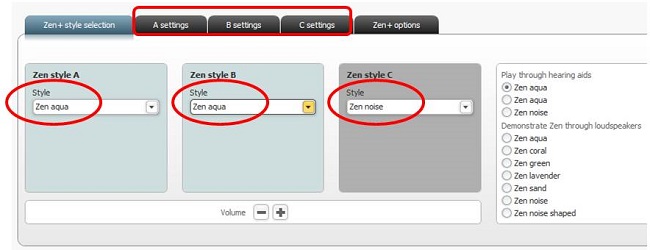
Figure 6. Basic Zen+ settings.
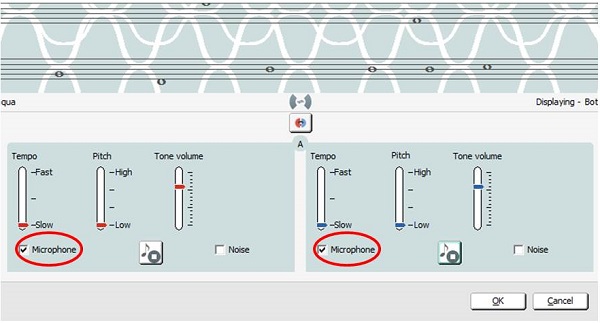
Figure 7. Zen aqua default settings.
To offer flexibility and control for your tinnitus patient, you can program Zen B as Zen noise (Figure 8). A patient will use the Zen-aqua-plus-amplification if hearing loss is present, as well as the Zen noise. Our patient Gloria will likely not need to use Zen B, but we can instruct her that if she having a bad day with her tinnitus, she can turn on Zen B. When she is in quiet or doing office work, we are going to instruct her to use Zen A.

Figure 8. Zen B settings, Zen aqua plus noise.
Zen C is only the noise and the microphone. Although Widex is not looking to mask tinnitus, for more severe tinnitus patients, the noise can be a useful tool earlier on in the treatment plan. Eventually, they can be weaned off and transitioned to listening to the Zen tones plus noise, and maybe eventually just the Zen. All of these options are discussed in Dr. Lesley Ericsson’s (2013) presentation, Practical Applications of Zen- Making Zen Easy, available on AudiologyOnline.
It is easy to do that three-step fitting process, but you have to remember to verify the Zen programs and make sure that the tones are audible but soft. Zen is based off of the in-situ thresholds from the Sensogram, so they are just barely there. They are treated as soft input. They will be at their loudest intensity when in quiet. When your patient is in an environment where there is some noise or conversation going on, they may not be able to hear the Zen if the microphones are engaged and they are using it as a traditional hearing aid. Of course, we hope that they will not be paying attention to their tinnitus at that point because they are engaged in conversation. You want to make sure that the tones are audible, but soft.
The Zen tones should not interfere with conversational speech. You have the ability to adjust the volume setting of the Zen tones as you saw in Figures 7 and 8. Make sure that the volume of the Zen tones is set so that the annoyance level of their tinnitus just begins to decrease. Many mild tinnitus patients do have this sign of relief almost immediately. This is rewarding to see, as they close their eyes and focus on listening to something that is relaxing. Eventually they are able to put that in the background and passively listen to something pleasant, which results in reducing the annoyance level of their tinnitus fairly quickly. For others, it does take time. It depends upon the severity of the patient’s tinnitus.
Counseling and Relaxation
Now that you have taken Gloria through her assessment process, fit her with hearing aids including the Zen and instructed her to utilize the Zen when she is quiet, you will want to touch upon some counseling and relaxation. We talked before about how these two elements are key to achieve a comprehensive treatment plan.
Why is it important to counsel? Information alone can take off the initial stress and anxiety that is often associated with one’s tinnitus. Tinnitus can be sustained in different areas of the brain, such as the limbic system. The limbic system is responsible for the emotional responses of the body. If it is unaware of what a stimulus is or thinks that it can cause harm, it is going to send off a fight-or-flight reaction and put that patient into a tinnitus stress cycle. Providing patients information about the nature of tinnitus and explaining that it is a symptom of hearing loss is going to be a stress reliever for that patient. Knowledge is power, and as professionals, we are the ones from whom patients should be receiving their information. We always want to advise our tinnitus patients to stay offline and come to us for information.
The Widex Zen Therapy program offers several different counseling tools to help support you and your patient through this process, including information on lifestyle and diet. Salt and alcohol intake can exacerbate tinnitus. We can give them information about how to make modifications to their lifestyle.
It is beneficial to help patients with severe tinnitus understand that there is a correlation between their emotions and their tinnitus. The response of the limbic system allows the brain to associate the sound as something negative. Learning how to take the negative emotion associated with tinnitus and think about it in a different way or understand that this is not something that will harm them is an important counseling approach. The advanced course by Dr. Ericsson (2013) addresses these types of strategies, including cognitive behavioral intervention, which is a successful tool in more severe tinnitus patients that helps to identify the emotional impact of tinnitus and control its impact on quality of life.
Counseling is an imperative component, whether on a basic level of providing information about the brain’s association with their tinnitus or lifestyle and diet, or even more advanced levels of counseling, such as the cognitive behavioral therapy. Counseling will allow for the patient to be more involved with their treatment plan as they know more information; it will make sense to them. It is an effective way to break the tinnitus stress cycle, as well as using the Zen tones. Treating the hearing loss will help to reduce stress as well. Hearing loss alone can be stressful, especially for a patient who is very active and becomes isolated from their everyday activities because they cannot hear.
The Widex Zen Therapy program offers a variety of different relaxation and sleep improvement techniques as part of our comprehensive approach. As I mentioned before, this was a general overview for the Widex Zen Therapy, but there are other associated tools and strategies to support you and your patient throughout this process. Who couldn’t benefit from some simple relaxation strategies on an everyday basis? Anything that we can do to be able to relieve stress in our lives is going to make for a healthier mindset and physical being.
Once we have implemented the treatment plan with Gloria, it is time for follow-up. As with any hearing aid patient, it is important to schedule an appropriate follow-up session following the initial fit. We recommend a two-week follow-up, followed by one month, three months, and then six months. However, this is something that you can tailor to the needs of your patients and your practice structures. It is important to be able to track progress from the pre-fitting through the post-fitting. Around the one-month post-fitting mark, you will want to repeat the subjective measurement scale that you did in the assessment, which gave you a baseline score. Hopefully over time, that score has gone down. This is useful for you to make sure that everything you are doing in the treatment plan is offering enough of what they need, both in terms of physical support and counseling. Perhaps you will need to incorporate some relaxation exercises or do some fine-tuning of the programs. Repeating these subjective scales gives you information on how your patients are doing. It is great for tracking progress and showing the patient how well they are doing. It is also important to let our patients know that we need to set realistic expectations as we move through the treatment plan. For some patients, this takes time. It is important always to keep that in mind and revisit goals throughout the follow-up process.
Summary
Widex Zen Therapy is a comprehensive program which offers the most effective tinnitus features - amplification makes soft sounds audible, taking away the contrast between silence and tinnitus, and the precision and broadband frequency response in our hearing aids allows for extended audibility to stimulate more of the central auditory pathways. Those unique features alone are all in a Widex hearing aid, coupled with multiple sound stimulation options and unique Zen fractal tones. The Zen fractal tones are the best choice as a form of sound therapy for many, if not all, of your tinnitus patients. Because we have the flexibility within the software to program with or without amplification, this is something that can be used for all of your tinnitus patients - not just the ones with hearing loss. We also offer a number of affordable and flexible wearing options in all of our product families.
Widex has a variety of support materials in the Widex Zen Therapy tool box. Some of those are listed in Figure 9, with the current order codes in blue so that you can contact Widex or your regional sales and training team and obtain any of those for your offices and start implementing them within your patients’ treatment plans.
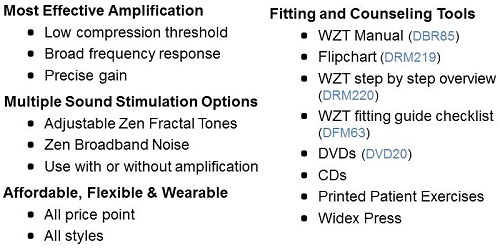
Figure 9. Comprehensive Zen Therapy program components and resources.
Widex Zen technology is the proven choice for sound therapy that is simple and effective. Widex Zen Therapy provides a comprehensive and step-by-step approach to implement tinnitus management as a service in your office. Widex is the premier company for tinnitus management. We have enjoyed several years of success using our Zen technology alone; combining this with our Widex Zen Therapy now offers the clinician and the patient a comprehensive management program.
Questions and Answers
Do you use the noise program exclusively for patients who do not find the musical tones relaxing?
The noise is available, but that is why we offer a variety of different tools and flexible options, even down to the Zen shaped noise in our Dream 440. We know that masking is not a permanent solution for tinnitus. We need to be able to offer them more of a permanent ongoing sound therapy solution that can mingle in the background with their tinnitus. You can refer to Dr. Ericsson’s (2013) presentation for more detailed information on how to select those tones for your patients.
How do we obtain the forms such as the TFI, TRQ, and THI?
The forms are available through Widex. You are able to order and download these forms from WidexPro or order them directly from customer service. The TFI is something that can be sent via PAD. You cannot download it online electronically, but it is something that can be ordered via PAD.
References
Kuk, F., & Peeters, H. (2008). The hearing aid as a music synthesizer. Hearing Review, 15(11), 2-6.
Sweetow, R. W., & Henderson, S. J. (2010). Effects of acoustical stimuli delivered through hearing aids on tinnitus. Journal of the American Academy of Audiology, 21(7), 461-473.
Kuk, F., Peeters, H. & Lau, C. (2010): The efficacy of fractal music employed in hearing aids for tinnitus management. Hearing Review, 17(10), 32-42.
Herzfeld, M., & Kuk, F. (2011). A clinician’s experience with using fractal music for tinnitus management. Hearing Review, 18(11), 50-55.
Sekiya, Y., Takahashi, M., Kabaya, K., Murakami, S., & Yoshioka, M. (March, 2013). Using fractal music as sound therapy in TRT treatment. AudiologyOnline, Article 22265. Retrieved from https://www.audiologyonline.com.
Cite this content as:
Epstein, M. (2014, January). Tinnitus management fundamentals: Widex Zen therapy. AudiologyOnline, Article 12367. Retrieved from: https://www.audiologyonline.com


